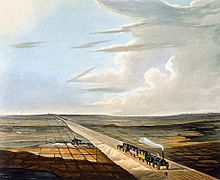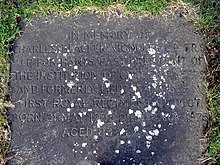Charles Vignoles
Charles Blacker Vignoles (born May 31, 1793 in Woodbrook ( County Wexford ) in Ireland , † November 17, 1875 in London ) was an early railway engineer . A standard form of railroad track , the Vignole track , is named after him.
youth

An orphan at an early age , he came to England and grew up with his grandfather, a professor at the Royal Military Academy Woolwich . He was trained as an officer at Sandhurst Military Academy . From 1814 he served in the British Army, for which he was in action in Holland, Canada and the USA. He then turned to surveying and was also active as a travel writer, mainly in the USA until 1823 .
Bridge builders
Vignoles then returned to Great Britain, where he oversaw the docks of London in the service of James Walker . During this time he also began to design bridges . One of its first was the Hammersmith Bridge . He founded his own engineering firm and so came up with other leading engineers of his time together, dedicated to civil engineering structures , bridges and tunnels involved, such as Thomas Telford , Isambard Brunel and the brothers George and John Rennie.
Around 1850 Vignoles built the great Nicholas Chain Bridge from Kiev over the Dnieper , the longest chain bridge in Europe.
Railway engineer
London and the Brighton Railway
The Rennie brothers were commissioned to develop a railway line from London to Brighton and hired Vignoles to survey it, which he completed within four weeks, and his proposal for the route turned out to be so excellent that it was used for the subsequent construction of the London and Brighton Railway was taken over.
Liverpool and the Manchester Railway

Vignoles then helped build the Liverpool and Manchester Railway (L&MR). The final route is based on his measurement and he succeeded in obtaining the legal basis for the construction of the railway from Parliament .
In a first attempt in 1824/25 was George Stephenson tried the project in the responsible committee to represent the Parliament. The self-taught George Stephenson spoke in a northern English dialect for people who spoke standard English was difficult to understand. The MPs were therefore suspicious of the project. The majority of them could not imagine that a railway of this dimension (56 km) could work. The draft law was put on the parliamentary committee's agenda 38 times within 10 weeks. Stephenson was no match for the legally trained and rhetorically superior MPs. This gave the impression that the calculations on which the bill was based were imprecise. Thereupon the MPs who introduced the draft withdrew the project. Stephenson's reputation suffered from this parliamentary defeat. The L&MR fired him and appointed George and John Rennie as new senior engineers. Charles Vignoles brought these with him, who re-measured the route by the end of 1825. He then represented the amended plans, which have now been introduced into parliament as a second bill, before the committee. This second bill received parliamentary approval and was signed by King George IV on May 5, 1826 .
Since the Rennies made unacceptable demands against the L&MR and the parliamentary hurdle had been overcome, George Stephenson was appointed again as the engineer in charge. Vignoles initially stayed, but fell out with George Stephenson, who pushed through his dismissal in 1827.
Further rail projects
Vignoles got involved in other rail projects, so the
- Wigan Branch Railway , England
- St. Helens and Runcorn Gap Railway , England
- Dublin and Kingston Railway , Ireland, the island's first long-distance rail link.
- Midland Counties Railway , England, opened in 1839, linking Nottingham , Derby and Leicester with Vignoles being the chief engineer.
- Sheffield, Ashton-Under-Lyne and Manchester Railway , England, including the first Woodhead Tunnel.
In 1834, together with John Taylor, he was commissioned by King George IV with surveying and leveling work for the planned route from Lehrte to Harburg . King Ernst August released him from this job in 1839, as the route proposed by Taylor and Vignoles was supposed to take the shorter route via Soltau and leave Uelzen and Lüneburg off the route.
In 1843, Vignoles was appointed by the Württemberg government as an appraiser to assess and revise the planning for the main lines, as crossing the Swabian Alb was particularly difficult. Since Vignoles considered steeper gradients than 1: 100 impossible, his proposals were very cautious and would have led to longer and more expensive railway constructions. His report was partially criticized as "superficial". The rapid progress at the time in building stronger locomotives soon made this caution superfluous and the railways were instead built according to plans by Karl Etzel .
From 1853 he worked for the Wiesbaden railway company and its successors on the Nassau Rheinbahn from Wiesbaden to Oberlahnstein .
From 1857 to 1864 he was in service with the Tudela-Bilbao Railway in Spain.
Vignole rail
In 1836, Vignoles recommended the London and Croydon Railway Company to use a flat-footed rail profile developed by railroad engineer Robert Livingston Stevens around 1830. This type of rail soon became the standard in the railway construction and in technical terminology as Vignol known
Honors
Since 1827 Vignoles was a member of the Institution of Civil Engineers , in 1841 he was appointed first professor of engineering at University College in London. Since 1855 he carried the title Fellow of the Royal Society .
literature
- Simon Garfield: The Last Journey of William Huskisson . Faber and Faber, 2002. ISBN 0-571-21048-1 .
- Philip J. Ransom: The Victorian Railway and how it evolved . Heinemann, London 1990, ISBN 0-434-98083-8
Web links
- Literature by and about Charles Vignoles in the catalog of the German National Library
Individual evidence
- ↑ Garfield, pp. 87f.
- ^ Garfield, p. 89.
- ^ Garfield, p. 89.
- ^ Garfield, p. 52.
- ↑ Garfield, pp. 92ff.
- ↑ Garfield, p. 98.
- ^ Garfield, p. 127.
- ↑ Gerd Wollenweber and Horst Buchholz, "Bienenbüttel und die Eisenbahn", p. 10, Bienenbüttel municipal archive 2013 - primary source A922 / 021 Hamburg State Archive.
- ↑ Eisenbahn Zeitung 1845, No. 23, page 196 of June 8 and No. 24, page 205 of June 15, 1845
| personal data | |
|---|---|
| SURNAME | Vignoles, Charles |
| ALTERNATIVE NAMES | Vignoles, Charles Blacker (full name) |
| BRIEF DESCRIPTION | British railway engineer |
| DATE OF BIRTH | May 31, 1793 |
| PLACE OF BIRTH | Woodbrook, County Wexford , Ireland |
| DATE OF DEATH | November 17, 1875 |
| Place of death | London |


